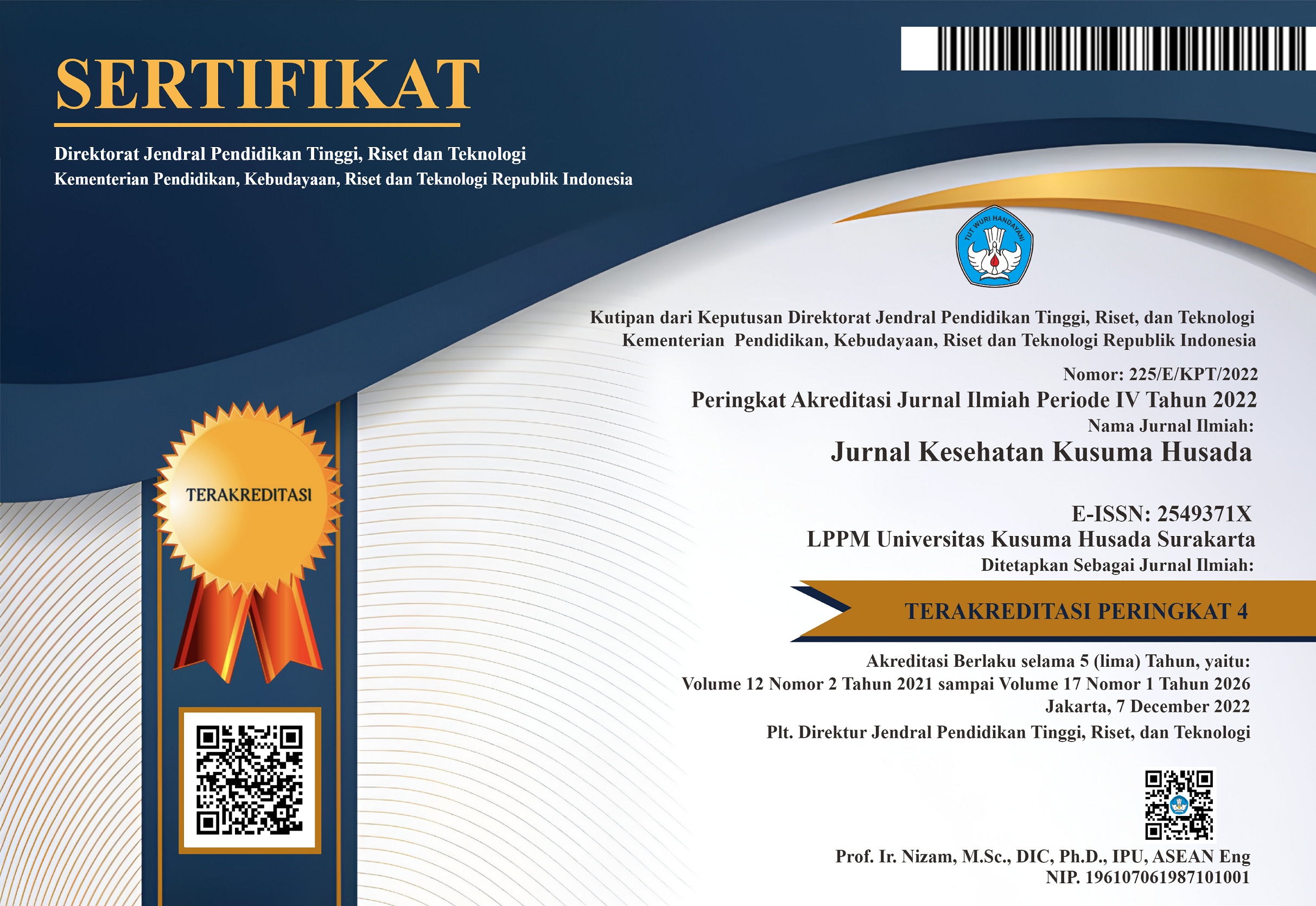POTENSI DIURETIK FRAKSI EKSTRAK ETANOL DAUN SELEDRI (Apium graveilens Linn.) SECARA INVIVO SEBAGAI HERBAL ANTIHIPERTENSI
Abstract
Hipertensi merupakan penyakit kenaikan tekanan darah lebih dari 140 mmHg. Hipertensi merupakan masalah utama kesehatan di dunia dan jumlah penderita semakin meningkat dari tahun ke tahun. Seiring dengan meningkatnya prevalensi hipertensi di Indonesia dan banyaknya faktor yang berpengaruh dalam pemilihan obat-obatan antihipertensi sintetik, maka dituntut terus untuk mengembangkan obat yang berasal dari alam. Seledri (Apium graveolens) telah diketahui mempunyai aktivitas antihipertensi dengan adanya kandungan apigenin yang berperan sebagai antagonis kalsium sehingga mempunyai efek vasodilatasi atau vasorelaksasi. Tujuan : Diketahuinya Tingkat dosis yang efektif dari ekstrak daun seledri sebagai obat hipertensi. Metode : Penelitian eksperimental post test only control group design. Hasil : Kelompok I (Dosis Ekstrak 300mg) memiliki Frekuensi BAK 4 kali, volume urin 1,80ml dan Potensi daya diuretic 20%, Kelompok II (Dosis Ekstrak 400mg) memiliki Frekuensi BAK 5 kali, volume urin 2,50ml dan Potensi daya diuretic 67%, Kelompok III (Dosis Ekstrak 500mg) memiliki Frekuensi BAK 6 kali, volume urin 2,85ml dan Potensi daya diuretic 90%, Kelompok IV (Furosemida) memiliki Frekuensi BAK 8 kali, volume urin 2,80ml dan Potensi daya diuretic 87%, Kelompok V (Aquades) memiliki Frekuensi BAK 4 kali, volume urin 1,50ml dan Potensi daya diuretic 0%. Kesimpulan : Potensi daya diuretic action yang paling tinggi dan efektif adalah kelompok III (dosis ekstrak daun seledri dosis 500mg) sebesar 90% karena memiliki efek frekuensi Buang air kecil (BAK) 6 kali dan volume urine 2,85 ml dibandingkan dengan kelompok lain.
Hypertension is a disease of increasing blood pressure more than 140 mmHg. Hypertension is a major health problem in the world and the number of sufferers is increasing from year to year. Along with the increasing prevalence of hypertension in Indonesia and the many factors that influence the selection of synthetic antihypertensive drugs, it is demanded to continue to develop drugs derived from nature. Celery (Apium graveolens) has been known to have antihypertensive activity in the presence of apigenin which acts as a calcium antagonist so that it has a vasodilating or vasorelaxation effect. Objective: To determine the effective dose level of celery leaf extract as a hypertension drug. Methods: Experimental research post test only control group design. Results: Group I (Extract dose 300mg) had urinary frequency 4 times, urine volume 1.80ml and diuretic power potential of 20%, Group II (extract dose 400mg) had urinary frequency 5 times, urine volume 2.50ml and diuretic power potential 67 %, Group III (Extract dose of 500 mg) has a urinary frequency of 6 times, urine volume is 2.85 ml and diuretic power potential of 90%, Group IV (Furosemide) has a urinary frequency of 8 times, urine volume is 2.80 ml and potential diuretic power is 87%, Group V (Aquades) had urinary frequency 4 times, urine volume 1.50 ml and diuretic potential of 0%. Conclusion: The highest and most effective potential for diuretic action is group III (500mg dose of celery leaf extract) by 90% because it has an effect of 6 times urination frequency and 2.85 ml urine volume compared to other groups.
Copyright (c) 2022 Jurnal Kesehatan Kusuma Husada

This work is licensed under a Creative Commons Attribution 4.0 International License.
The copyright of the published articles belongs to Jurnal Kesehatan Kusuma Husada.

This work is licensed under a Creative Commons Attribution 4.0 International License.











